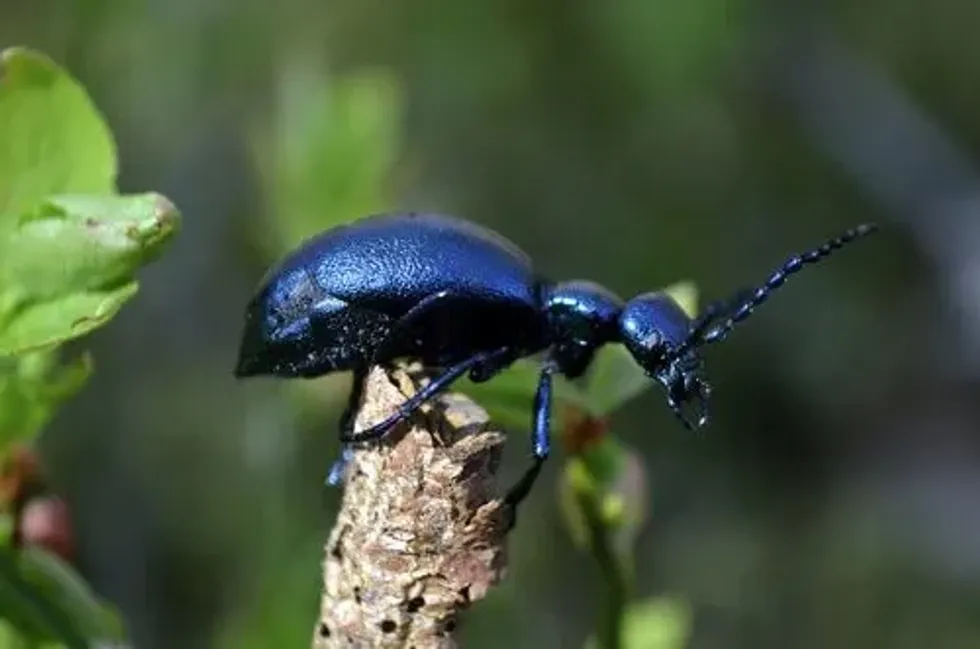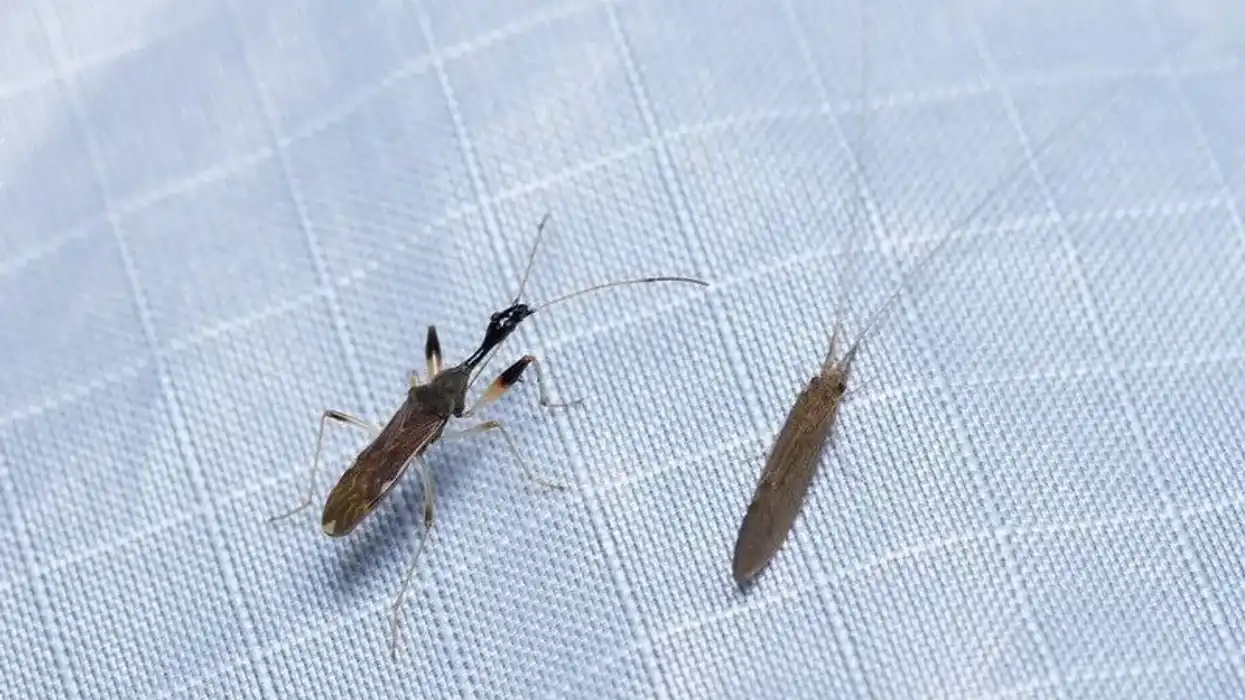Oil beetles refer to a genus of oil-secreting beetles which can mainly be found in North America and Europe. These beetles are named after the oily substance which they secrete from glands positioned on their knees when threatened that can cause painful blisters if it comes in contact with human skin.
These beetles are small, hard, and shiny black with short wings and long antennae. They cannot fly due to their unnaturally small wings, instead, they hitch rides by hanging onto unsuspicious bees and laying their eggs near their hives. Oil beetle larvae are insectivorous in nature with adult beetles being strict vegetarians.
To learn more about this interesting genus, read on! For more relatable content, check out these atlas beetle facts and water beetle facts for kids.
Oil Beetle Interesting Facts
What type of animal is an oil beetle?
Oil beetles refer to around 31 species of oil-secreting beetles which belong to the genus Meloe.
What class of animal does an oil beetle belong to?
The oil beetle (Meloe) belongs to the class Insecta.
How many oil beetles are there in the world?
The exact population of this type of beetle is unknown as it refers to a vast genus with 31 species. However, they are quite commonly found all over the world and are currently in no danger of extinction.
Where does an oil beetle live?
Oil beetles are found all over the world, however, they can mostly be found in North America and Europe. American oil beetles are the most widely spotted in this genus.
What is an oil beetle's habitat?
Oil beetles normally latch onto bee larvae as parasites and can be found in areas where bees are commonly observed. They thrive in wildflower-rich fields and heathlands, living around the plants they normally feed on.
Who do oil beetles live with?
The blister beetle species have a parasitic relationship with bees. They often attach themselves to a solitary female bee by waiting on flowers or in the grass and accompany them to their hives.
Once near the hives, they lay eggs in an underground nest that hatches into larvae and enters the hives with the bees. Once inside, the beetle larvae feed on the same food as the bee larvae until they emerge fully grown.
If not contained, these blister beetle species may grow into swarms which can be very harmful to fruit and vegetable plantations and gardens.
How long does an oil beetle live?
Adult oil beetles have a lifespan of a little over three months.
How do they reproduce?
Male and female adult oil beetles pair up and mate, after which the female will burrow into a nest near a beehive and lay around 1,000-10,000 eggs.
After these eggs hatch, the larvae will climb up flowers and wait for female solitary bees to pass by, attaching themselves to them and making their way back to the beehive.
Inside, they will live among the bee larvae and eat the same food as them, molting three times until they reach adult stage, after which they will emerge from the beehive during the spring and live among the grasslands.
What is their conservation status?
As these beetles are fairly abundant in America, most blister beetle species are of Least Concern. The Meloe genus as a whole has been given the status of not extinct. However, they are rare in the UK with some European species being Vulnerable.
Oil Beetle Fun Facts
What do oil beetles look like?
Oil beetles are mostly pure black in color with a hard, shiny shell, and thick abdomen. They have short wings which are not proportionate to their body, making it impossible for them to fly.
Each species looks slightly different in terms of structure, however, they all share the hard black exterior, six legs, and two long antennae which are the main characteristics of this genus. Blister beetles have oil glands located on their knees which secrete a toxin called cantharidin when they feel threatened.
How cute are they?
Blister beetles are not very cute. They look like typical creepy crawlies with their long antennae and hard shiny bodies which makes them quite unappealing to the general public.
How do they communicate?
Beetles communicate using a variety of means. Most beetles communicate by secreting and sensing chemicals which is how males usually locate females during the breeding period. They will scrape together their mouthparts and knees to make rasping noises, and bang their feet against hollow wood to cause vibrations to relay messages to any nearby insects.
How big is an oil beetle?
Adult oil beetles have been observed to measure 0.3-1.2 in (7-30 mm) from head to abdomen.
How fast can oil beetles move?
Blister beetles are very slow and do not fly due to their wings being unnaturally short. They usually catch rides by lying in wait and then latching on to bees, mostly during spring when they are most active.
How much does an oil beetle weigh?
The weight of the oil beetle (Meloe) is unknown, however, it is very light due to it being such a small insect.
What are the male and female names of the species?
There are no separate names for the males and females of this species.
What would you call a baby oil beetle?
Baby oil beetles are called larvae or grubs.
What do they eat?
Blister beetle larvae are insectivorous in nature, feeding on the same food as bee larvae and often on the bee larvae themselves. Once they molt into adults, they follow herbivorous diets feeding on grass, seeds, and various flowers.
Are they harmful?
These insects are named after the oily substance they secrete when they feel threatened. This substance, known as cantharidin, makes them taste bad to predators and often leaves blisters on the skin of whoever handles it.
The cantharidin toxin can harm human skin with the blisters being painfully itchy and taking a very long time to heal. Due to this, they are commonly also known as blister beetles.
Would they make a good pet?
No, these beetles require the presence of bees and bee larvae in order to feed on and grow which can mostly be found in grasslands and fields.
Due to the toxic nature of their secretions, they are not very susceptible to being handled and will not make good pets for bug enthusiasts. They have also been labeled as pests as they feed on fruits and vegetables in gardens.
Accidentally swallowing these beetles may cause severe infections and in some cases even death, due to the high amount of toxins they possess.
Did you know...
As they cannot fly, these insects often make their way to beehives by attaching themselves to a visiting female bee which unknowingly carries beetle larvae on her body.
In small numbers they can actually be useful in a garden, removing any grasshopper eggs which can hatch and wreak havoc on garden vegetation.
What are the different types of oil beetles?
There are 31 different species of oil beetles in the Meloe genus. They mostly differ in shape with all beetles having a hard black shell. They only differ in location with most species being found in North America itself.
How to get rid of oil beetles?
These blister beetles can be quite persistent and a potent spinosad insecticide is needed in other to rid them from one's gardens or homes.
They can also be removed manually from plants if they are less in number, but wearing rubber gloves before handling them is a must to prevent painful blisters. Other measures can be taken to prevent inviting these beetles into your garden by omitting pigweed, ironweed, and ragweed which these beetles are quite fond of.
The spreading of diatomaceous earth also helps to kill these beetles, preventing future outbreaks as well.
Here at Kidadl, we have carefully created lots of interesting family-friendly animal facts for everyone to discover! Learn more about some other arthropods from our green June beetle surprising facts and ground beetle interesting facts pages.
You can even occupy yourself at home by coloring in one of our free printable oil beetle coloring pages.
Thank you to Kidadler Paul White for providing the image of an oil beetle in this article.









